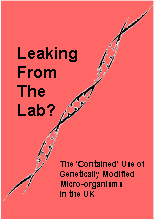Laboratory and Industrial Use

All genetically modified organisms (GMOs) are first developed in laboratories and some are designed never to be released into the wider environment. Others are used in industrial processing. Because they are not deliberately released into the environment, they are said to be 'contained'.
Historically, GM microorganisms (such as bacteria and viruses) have been retricted to contained use, because of concerns about the risk to human and animal health and the environment that could follow from open releases. This includes GM microorganisms produced using newer gene editing (GE) techniques. However, some GM (including GE) microorganisms are now being developed for open release into the environment. These raise major concerns about environmental impacts.
'Synthetic biology' is one term used to describe when scientists have begun to create or recreate microorganisms from scratch - by joining pieces of DNA together - or where synthetic DNA has been included in genetic engineering, usually of microorganisms.
The more common contained uses of GMOs include:- In research to understand how animals, plants and microorganisms function and to understand and develop treatments for disease;
- In product development of GM crops, animals or bacteria;
- In factories using GM bacteria and yeasts to produce :
- industrial enzymes, such as those used in detergents;
- enzymes for food manufacture, such as renin for cheese production;
- drugs, such as insulin.
In Europe, all laboratory and factory uses of GMOs are regulated by the EU Contained Use Directive, and similar regulations are followed in the UK
Resources
- Press articles
- BBC: Fatbergs turned into perfume - inside Britain's bizarre new industrial revolution (15th January 2025)
- The Intercept: In Its Zeal to Blame China for Coronavirus, the Trump Administration Is Thwarting Investigations Into the Pandemic's Origins (19th May 2020)
- NPR: As Made-To-Order DNA Gets Cheaper, Keeping It Out Of The Wrong Hands Gets Harder (24th September 2019)
- Slate: The Existential Consequences of Lab Errors (26th August 2019)
- GreenBiz: Just how sustainable is that synbio startup? (23rd July 2019)
- Medium: Impossible Foods, Impossible Claims (22nd July 2019)
- The Guardian: Cambridge scientists create world's first living organism with fully redesigned DNA (15th May 2019)
- New York Times: Scientists Created Bacteria With a Synthetic Genome. Is This Artificial Life? (14th May 2019)
- EurActiv: EU food alert system exposed to antimicrobial resistant contamination (25th October 2018)
- C&EN: Activists warn of algae escape (2nd October 2017)
- Business Insider: One of the most controversial Kickstarter campaigns in history is dead - here's the product that actually got made (27th August 2017)
- Independent Science News: Illegal GE Bacteria Detected in An Animal Feed Supplement (26th June 2017)
- Reuters: How artificial life spawned a billion-dollar industry (6th April 2017)
- The Guardian: Organisms created with synthetic DNA pave way for entirely new life forms (24th January 2017)
- Fast Company: The Rise And Fall Of The Company That Was Going To Have Us All Using Biofuels (8th August 2012)
- Press Releases
- GeneWatch PR: GM experiments to create new life forms could take place in the UK without public debate, GeneWatch UK warns 22nd November 2002
- GeneWatch PR: Massive public support for tighter control of GM waste 10th January 2000
- GeneWatch PR: GM micro-organisms released into the environment every day across the uk, says new GeneWatch UK report 27th June 1999
- GeneWatch PR: GM Could be Used in up to 90% of Processed Food, Says GeneWatch UK 15th February 1999
- Reports
- Briefings
- Links

